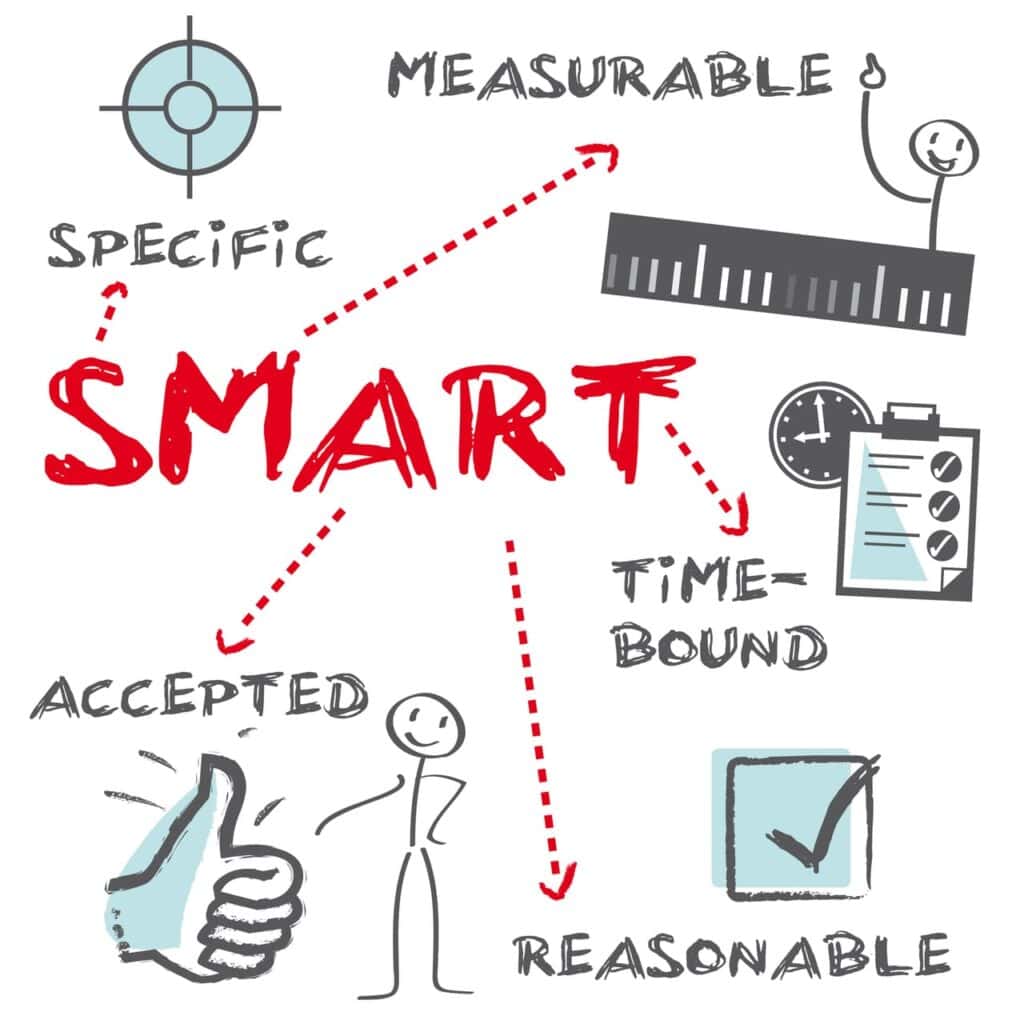In the fast-paced world of sales, where change is the only constant, how do we create a blueprint for success? How can sales leaders set the compass for their teams, ensuring that they are marching in the right direction, armed with the best strategies?
The Imperative of Goal Setting in Field Sales
Embarking on a journey in the field sales realm without defined goals? That’s like setting sail on turbulent waters without a compass or map. The waves of competition and the changing winds of market demand can quickly steer you off course.
That said, it’s high time we delve deeper into why goal setting in field sales isn’t just recommended but essential.
Directing Focus and Efforts
Picture being an archer with a bow and arrow. Where do you aim when there’s no target in sight?
Goal setting acts as that critical target, giving sales representatives a clear direction. It consolidates their efforts, ensuring they’re not just shooting in the dark but have a specific objective in their crosshairs.
This clarity in vision not only elevates their motivation but also streamlines their daily activities, ensuring every move they make, and every strategy they adopt, is aligned with the larger goal.
Enhancing Skill Development and Training
Consider this: a pianist doesn’t merely play random notes each day. They practice specific pieces, aiming for perfection.
Similarly, with clear sales goals, representatives have a purpose for their training. They can identify areas of improvement, work on particular skills, and ultimately become masters of their trade.
Think of goal setting as the sheet music guiding a musician, enabling them to produce a melodious symphony of sales success.
Establishing Accountability and Ownership
When goals are explicit, there’s a tangible benchmark against which performance can be measured. It creates a culture of accountability, where sales representatives take ownership of their successes and failures.
When they hit their targets, the sense of accomplishment is palpable. And if they fall short? It’s a learning opportunity, a moment of introspection, encouraging them to analyze, adapt, and come back stronger.
There’s no ambiguity; there’s just clear, actionable feedback.
Driving Team Collaboration and Unity
Remember those team-building exercises where everyone had to work together to achieve a common objective? Field sales goals serve a similar purpose.
When everyone knows the destination, they can collectively map out the best route. They collaborate, share insights, pool resources, and, most importantly, support one another.
This collective pursuit fosters unity, ensuring that the team isn’t just a group of individuals but a cohesive unit, marching forward with shared ambition.
Providing a Barometer for Strategy Refinement
In the dynamic world of sales, stagnation is the real enemy. But how do you know when it’s time to pivot or persevere? Hence, field sales goals.
These objectives provide real-time feedback on strategies, highlighting what’s working and what needs a rethink. If a particular approach consistently helps achieve goals, it’s a keeper. But if another continually falls short? It’s a signal for revision, ensuring the sales process remains agile, relevant, and effective.
To cap it off, goal setting in field sales isn’t a mere administrative task. It’s the heartbeat of the sales process, ensuring that every step taken is purposeful, progressive, and potent.
So, whether you’re a seasoned sales leader or a budding representative, remember this: Goals aren’t just milestones; they are the very essence of the journey.
Crafting SMART Goals for Field Sales
Much like that architectural blueprint, SMART goals are the structural foundation of your field sales success. But what exactly are SMART goals? Let’s delve deeper.
Specific
In the fast-paced world of sales, having clear goals is like a guiding light in uncertain waters.
Being specific is crucial. Vague goals are like trying to hit a target blindfolded – success becomes unlikely. On the flip side, precise goals focus your efforts and amplify your sales journey’s purpose.
Keep in mind that a clear goal is halfway to achievement. Now, let’s explore practical tips for harnessing this power.
- Define your goal in simple terms.
- Narrow down broad objectives.
- Seek feedback from peers or mentors.
- Document the goal for consistent reference.
- Discuss with team members for alignment.
- Avoid using ambiguous terms.
- Revisit and refine if circumstances change.
Measurable
Making your goals measurable turns them from ideas into clear markers on your path to sales success.
Numbers and metrics become your checkpoints, confirming you’re on track and giving you the confidence to continue. Regularly checking these metrics not only tells you how well your strategies work but also provides insights to refine them.
In the world of sales, think of measurability as the beat that keeps your efforts in sync with your goals. To make the most of measurability, consider these practical tips.
- Establish key performance indicators (KPIs).
- Use tracking tools or software.
- Schedule regular reviews of these metrics.
- Compare current metrics to historical data.
- Adjust strategies based on metric feedback.
- Celebrate milestones reached.
- Use metrics to identify areas for training or upskilling.
Attainable
Ambition drives success, but we must avoid steering into troubled waters. Overextending, driven by enthusiasm, can lead to burnout, dampening morale and productivity. It’s like sprinting through a marathon—starting strong is good, but sustaining it is tough.
Effective goal-setting finds the balance, where challenges motivate yet are realistically achievable.
Setting attainable goals ensures steady progress, paving the way for lasting success and growth. Remember, the brilliance of goal-setting lies in building the ladder, step by achievable step, toward your ultimate destination.
To ensure your goals are realistic, consider these insights.
- Evaluate current resources and limitations.
- Break the goal into smaller milestones.
- Seek advice on feasibility from experienced peers.
- Reassess if a target seems too easy or too hard midway.
- Celebrate small wins to maintain motivation.
- Stay updated with market trends to ensure relevancy.
- Adjust goals based on changing circumstances or new information.
Relevant
In the pursuit of success, it’s not just about choosing a goal but making sure it aligns with your team and company’s vision. It’s like guiding a boat; if the crew paddles in different directions, the journey becomes chaotic.
Similarly, in the world of sales, staying relevant serves as your guide, making sure every effort contributes to a common purpose.
Setting relevant goals is like blending your tune with the larger symphony of your organization’s dreams. When each goal harmonizes with the bigger picture, the result is not only captivating but also victorious.
Remember, every goal is a step, but its relevance ensures it’s a step in the right direction. To ensure your goals stay relevant, let’s explore these practical guidelines.
- Understand the company’s long-term vision.
- Discuss goals with team members for alignment.
- Prioritize goals that have a direct impact on the company’s mission.
- Avoid setting goals based on external pressures or fleeting trends.
- Regularly reevaluate the relevancy of set objectives.
- Encourage open communication for feedback.
- Ensure personal career growth aligns with company growth.
Time-bound
The ticking clock isn’t just a reminder of time passing; it’s a push to act purposefully. Time, when used wisely, is a strong ally in reaching our goals. Without deadlines, even well-defined goals can drift into complacency and procrastination.
Setting time limits ensures our aspirations don’t get lost amid daily tasks. By adding a timeline to our ambitions, we create urgency, fueling the drive to succeed. Embracing deadlines fuels our determination, ensuring consistent progress.
To master setting time-bound goals, follow these steps.
- Set clear start and end dates for each goal.
- Break down the timeline into smaller checkpoints.
- Use reminders or tools to stay on track.
- Review progress at regular intervals.
- Adjust timelines if necessary, but avoid frequent changes.
- Celebrate when milestones are met on time.
- Use missed deadlines as a learning opportunity to refine processes.
Arming yourself with the SMART strategy ensures you’re not just setting goals, but you’re charting out a defined path to success. It’s like having a GPS for your sales journey, guiding you turn by turn, all the way to your destination.

Leveraging Historical Data for Future Goals
History isn’t just a tale of times gone by. And this is specifically true in sales – it’s the blueprint that guides our path forward.
Think of past performances as a treasure trove, bursting with nuggets of invaluable insights. Reflecting on previous quarters gives you a panoramic view of your team’s strengths and areas ripe for improvement.
Which initiatives sparked success? Which ones require recalibration? Diving deep into historical data is like having a conversation with your past self, gleaning lessons, and charting a course brimming with potential.
By anchoring your goals in the wisdom of past experiences, you equip yourself with a potent toolkit for crafting future victories.
Prioritizing Goals for Maximum Impact
In the world of sales, as in life, prioritization is the secret sauce that can catapult your efforts from good to exceptional.
So, how do leaders sift through a plethora of objectives and zero in on the ones that truly move the needle?
Here’s a step-by-step guide to streamline your focus and ensure each goal packs a punch.
- Objective Inventory: At the beginning of every quarter, gather your team and jot down all potential goals.
- Financial Impact Analysis: Highlight goals that, when achieved, would significantly boost the company’s revenue or save costs.
- Morale Magnifiers: Identify objectives that, while not directly financial, uplift team spirit and motivation. Happy teams often equate to better performance.
- Foundation Builders: Pinpoint goals that lay the groundwork for future growth, even if the immediate benefits aren’t evident.
- Resource Assessment: For each goal, determine the resources – both time and material – it would demand.
- Impact Vs. Input: Now, place each goal on a scale, weighing its potential impact against the required resources. This helps in recognizing high ROI objectives.
- Delegate and Collaborate: Assign goals based on team members’ strengths and expertise. Encourage collaboration for complex objectives.
- Set Checkpoints: Break down long-term goals into monthly or even weekly milestones. It ensures consistent progress and timely course corrections if needed.
- Re-evaluate Regularly: The business environment is dynamic. Ensure you’re not clinging to outdated objectives by reviewing and tweaking them regularly.
- Celebrate Small Wins: As you progress, take moments to celebrate the little victories. It fosters motivation and keeps the momentum going.
Remember, the beauty of prioritization is that it doesn’t just guide you on where to focus, but also offers clarity on what can wait. By sharpening your goal-setting prowess, you’re not just aiming for success; you’re strategizing for significance.
Designing a Comprehensive Field Sales Action Plan
So, you have your goals in place. But goals without a plan are like arrows without a target. They lack direction.
Crafting a comprehensive action plan, therefore, is paramount.
To guide you through this intricate journey and ensure you emerge triumphant, we’ve curated a structured checklist. Let’s dive deep into each component to understand its role and significance.
1. Activities and Strategies: The Game Plan
Activities and strategies are the backbone of your sales plan. Think of them as the tangible steps and tactics you’ll adopt to inch closer to your ultimate goals.
Remember, crafting a foolproof strategy involves analyzing myriad factors to ensure each step propels you forward.
- Action Alignment
- Feasibility
- Impact Assessment
- Resource Requirement
- Consistency
- Flexibility
- Feedback Loop
Your chosen activities and strategies are the roadmap for your sales journey. They provide clarity, direction, and a sense of purpose.
Moreover, they act as a bridge, converting aspirations into real-world achievements. A meticulously crafted strategy ensures that every effort is a step closer to the pinnacle of success.
For those looking to perfect their strategy, check out these tips and recommendations.
- SWOT Analysis: Assess strengths, weaknesses, opportunities, and threats to select the most potent tactics.
- Training Sessions: Equip your team with the knowledge and skills to execute strategies efficiently.
- Regular Reviews: Periodically assess the effectiveness of activities and refine them.
- Stakeholder Feedback: Engage team members for insights, as they’re on the frontline of implementation.
- Tech Utilization: Leverage CRM and sales analytics tools to streamline and monitor activities.
- Clear Communication: Ensure every member understands the strategy and their role in it.
- Contingency Planning: Always have a backup plan in case a chosen activity doesn’t yield the expected results.
- Rewards and Recognition: Motivate the team by acknowledging their efforts and successes.
An articulated strategy is the lifeblood of efficient field sales operations, turning vision into measurable outcomes.
2. Responsibilities: The Torchbearers
Responsibilities refer to the clear delegation of tasks. It’s about designating roles, ensuring every team member knows exactly what they’re accountable for.
Delegating isn’t just about assigning tasks; it’s about optimizing talents, streamlining efforts, and ensuring no stone remains unturned.
- Skill Alignment
- Task Clarity
- Feedback Mechanism
- Progress Monitoring
- Team Dynamics
- Training Needs
- Motivation
Delegating responsibilities ensures optimal use of your team’s capabilities. It fosters accountability, promotes efficiency, and guarantees that every task receives the attention it deserves.
Furthermore, when everyone knows their role, it builds confidence, creates a cohesive unit, and propels the team towards shared objectives.
Here are some tips for field sales leaders.
- Role Definition: Clearly outline each team member’s duties, expectations, and deliverables.
- Open Communication: Maintain an open door policy, encouraging team members to voice concerns or seek clarifications.
- Resource Allocation: Provide team members with the tools and resources needed to execute their tasks effectively.
- Team Meetings: Regular catch-ups to discuss progress, challenges, and potential roadblocks.
- Skill Development: Offer training sessions or workshops to bridge any skill gaps.
- Conflict Resolution: Address conflicts promptly to ensure smooth task execution.
- Performance Reviews: Conduct periodic reviews to provide feedback and appreciate efforts.
- Empower Decision Making: Trust team members with decisions about their responsibilities.
Responsibility delegation isn’t merely a task assignment; it’s about entrusting the team with the company’s vision and steering the ship together towards success.
3. Resources: The Power Tools
Resources, in this context, signify the tools, training sessions, and support mechanisms that empower the sales team to function at its best.
In the ever-competitive field sales arena, having the right resources at your disposal can mean the difference between triumph and just getting by. Here are some key factors field sales leaders should take into consideration.
- Tech Stack
- Training Modules
- Support Structures
- Budget Allocation
- Resource Accessibility
- Feedback Channels
- Continuous Upgrades
Resources are like the wind beneath the sales team’s wings; they enable, empower, and elevate. In a landscape where agility and efficiency reign supreme, having the right resources can drastically amplify results.
Moreover, by equipping your team with the best tools and training, you’re not only setting them up for success but also showcasing your commitment to their growth and excellence.
- Needs Assessment: Regularly communicate with the team to understand their resource requirements.
- Vendor Evaluation: Before investing in a tool or service, evaluate multiple vendors for cost-effectiveness and quality.
- Onboarding Training: When introducing a new tool, ensure the team is trained to use it effectively.
- Resource Optimization: Regularly assess the usage and effectiveness of current resources and phase out redundancies.
- Feedback Loop: Foster a culture where team members can suggest new tools or training programs.
- Budget Reviews: Periodically review the budget to ensure adequate allocation of resources without overspending.
- Peer Recommendations: Stay connected with industry peers to learn about the latest and most effective resources.
- Safety Protocols: If using digital tools, ensure data security and privacy protocols are in place.
A well-equipped team is an unstoppable force. By continually refining your resource toolkit, you pave the way for unbridled success.
4. Timelines: The Pacesetters
Timelines dictate the rhythm of your sales operations. They establish deadlines, set pacing, and provide a framework within which all activities must be completed.
A well-thought-out timeline doesn’t just provide structure, it acts as a motivational beacon, keeping the team aligned and driven. As field sales leaders, be sure to consider these key factors.
- Realism
- Milestones
- Flexibility
- Prioritization
- Team Input
- Regular Check-ins
- Buffer Time
Timelines serve as the heartbeat of your sales operations, ensuring that every task, big or small, moves towards completion in unison. They instill a sense of urgency, keep procrastination at bay, and allow for better resource planning.
Additionally, by maintaining a steady pace, you ensure that the entire sales cycle remains smooth, efficient, and devoid of last-minute scrambles.
- Goal Decomposition: Break down larger goals into sub-tasks and allocate individual timelines.
- Resource Matching: Align resource availability with task timelines to avoid bottlenecks.
- Progress Tracking Tools: Utilize tools like Gantt charts to visualize and monitor progress.
- Regular Team Sync-ups: Hold frequent meetings to ensure everyone is aligned and updated.
- Feedback Mechanism: Allow team members to communicate if they foresee potential timeline breaches.
- Contingency Planning: Prepare for unexpected delays by having backup plans in place.
- Time Management Training: Offer training sessions to improve the team’s time management skills.
- Celebrate Milestones: Recognizing the achievement of milestones can act as a motivation boost.
Effective timeline management is like setting the tempo for a harmonious symphony, ensuring every note, every beat, resonates with precision and purpose.

The Cycle of Monitoring, Adapting, and Refining
In the constantly shifting world of sales, success relies on setting goals and tirelessly striving for excellence. “Monitoring, Adapting, and Refining” is the interplay between ambition and reality, planning, and execution. Embracing this cycle ensures reaching targets and constructing a robust sales framework.
A. Monitoring: The Continuous Vigilance
In the dynamic realm of field sales, the act of monitoring is like a ship’s captain keeping a constant eye on the horizon. Regular oversight not only ensures that the ship remains on course but also that any impending storms are spotted well in advance.
The monitoring process goes beyond mere observation; it’s a calculated approach to understanding the nuances of the journey. By consistently keeping tabs on progress, leaders can swiftly identify areas of excellence or spots where intervention might be necessary.
Think of it as having your hand on the pulse of the operation. By continually measuring outcomes against benchmarks, you’re not just noting progress but ensuring proactive alignment with strategic objectives.
Every data point collected, every feedback heard, and every performance metric gauged, paints a clearer picture of the road ahead. In essence, monitoring is the bridge between planning and execution, ensuring that every effort aligns with the envisioned trajectory.
B. Adapting: The Dance of Evolution
Adaptation is the cornerstone of success in an environment marked by relentless change. Just as a seasoned sailor adjusts sails in response to changing winds, a savvy sales leader adapts strategies to the ever-shifting market dynamics.
This is not about abandoning the core plan but making smart, nuanced changes to fit the prevailing circumstances. It’s recognizing that while the destination remains fixed, the path to reach it might need to be fluid.
In the world of sales, the only constant is change. Customer preferences evolve, market trends shift, and new competitors emerge. The true mettle of a leader is tested not by their ability to craft a perfect plan, but by their agility in adapting when the ground beneath shifts.
By embracing adaptability, organizations ensure that they’re not just reacting to change but are equipped to leverage it. This nimbleness becomes a potent competitive advantage, allowing teams to pivot with grace and capitalize on emerging opportunities.
C. Refining: The Art of Perfection
Refinement is the pursuit of excellence. Once you’ve monitored the landscape and adapted to the challenges, the next step is to fine-tune your strategies. It’s the meticulous process of polishing every aspect of the sales operation to glean the best results.
Like a sculptor chiseling away to reveal the masterpiece within, refining is about recognizing the potential and working tirelessly to realize it.
Every endeavor, no matter how well-planned, can benefit from introspection and refinement. It involves sifting through data, understanding outcomes, and making informed decisions to enhance future performance. It’s not about overhauling everything but making targeted tweaks that can exponentially boost results.
By constantly refining, organizations ensure that they remain ahead of the curve, turning lessons learned into actionable insights.
This cyclical process of monitoring, adapting, and refining ensures that businesses remain robust, resilient, and ready to conquer the next challenge.
Empowering Your Sales Team: Support, Guidance, and Mentorship
A motivated sales team is the engine that drives success. But motivation isn’t always about grand gestures. Often, it’s about those little moments of support, guidance, and mentorship.
Recall a time when someone believed in you, even when you had doubts. Felt good, right? As leaders, we do more than just set goals; we support our team to help them achieve greater heights.
Support: The Backbone of Success
Every sales representative, regardless of experience, will face challenges. In these moments, unwavering support from their leaders can be a game-changer.
Think of support as the safety net that catches your team when they falter, ensuring they bounce back with even more vigor. It’s not about shielding them from challenges but giving them the confidence to tackle them, knowing their leadership has their back.
When team members feel supported, they’re inclined to take risks, innovate, and push boundaries.
- Open Door Policy: Foster a culture where team members can approach you with their concerns without hesitation.
- Regular Check-ins: Set aside time to connect with individual team members, understand their challenges and offer assistance.
- Resource Allocation: Ensure your team has access to the tools and training they need to succeed.
- Celebrate Failures and Wins: Recognize that every setback offers a lesson. Celebrate the journey, not just the destination.
- Active Listening: When a team member comes to you, listen actively. Sometimes, they may just need a sounding board.
Guidance: Charting the Path Forward
Guidance is the compass that points your team in the right direction. It’s the wisdom shared, the strategies discussed, and the goals clarified. Remember, even the most skilled sailor needs a star to navigate by, and that’s what your guidance provides to your sales team.
By offering clear actionable advice, leaders can help their team navigate the complex waters of field sales, ensuring they stay on course.
This guidance can come in many forms, from strategic planning sessions to one-on-one discussions, but its essence remains: to illuminate the path forward.
- Tailored Feedback: Understand each team member’s strengths and weaknesses, offering feedback that caters to their individual needs.
- Set Clear Expectations: Ensure that every member understands their role and the larger objectives at play.
- Strategy Sharing: Regularly discuss and revisit sales strategies, ensuring alignment and clarity.
- Skill Development: Identify areas of improvement and recommend training or courses that can bridge the gap.
- Role Modeling: Lead by example. Your actions and decisions can serve as a guiding light for your team.
Mentorship: Shaping Tomorrow’s Leaders
Mentorship goes beyond the immediate sales targets; it’s an investment in the future. When leaders take on the role of mentors, they impart not just skills, but values, ethos, and a legacy.
Think back to a mentor in your life; their influence likely shaped your career and decisions in profound ways. It’s your turn to lead your team, helping them enhance skills, fine-tune strategies, and grow personally and professionally.
Mentorship molds future sales leaders.
- One-on-One Sessions: Dedicate time for individual mentoring sessions, diving deep into career aspirations and growth.
- Share Personal Experiences: Your journey is rich with lessons. Share stories of failures, successes, and turning points.
- Constructive Feedback: Offer feedback that is not just about immediate tasks but about long-term growth and development.
- Set Challenges: Push your mentees out of their comfort zones, setting tasks that foster growth and resilience.
- Encourage Networking: Introduce them to industry peers, conferences, and seminars, broadening their horizons.
Remember, as sales leaders, our roles are multi-dimensional. It’s not just about numbers, but about people. By offering unwavering support, clear guidance, and dedicated mentorship, we don’t just meet sales targets; we shape futures.

Final Thoughts | Field Sales Goal-setting Framework
Field sales can be daunting, but with the right framework and strategies, it’s a challenge we’re all equipped to conquer. As we navigate the labyrinth of sales goals, remember this: it’s not just about the destination, but the journey. And every step, every milestone, every detour is a chapter in your success story.
After all, isn’t sales all about creating stories? Stories of grit, perseverance, and triumph. So, what’s your next chapter going to be?
Are you ready to redefine your sales journey? To craft goals that not only inspire but also empower? Dive in, take the plunge, and let’s make success a habit!
Got questions or personal experiences to share? We’d love to hear them!





